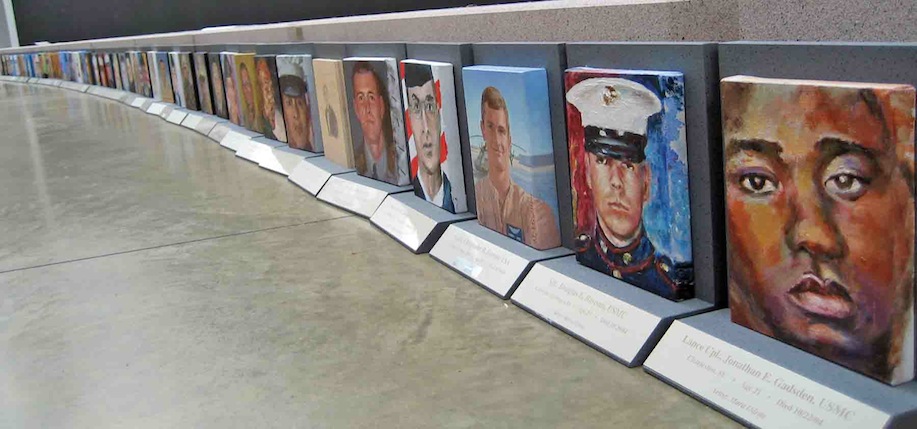The Faces of the Fallen exhibition, which commemorated the men and women of the U.S. Armed Forces who lost their lives in Iraq and Afghanistan, recently closed.
The story of Faces of the Fallen begins with a visual artist, a national newspaper and a cup of tea. When Annette Polan opened her morning Washington Post sometime in the fall of 2004 she saw, not just thumbnail photographs of her countrymen and women fallen in the first wars of a new century, but a portrait gallery. She determined to paint these portraits.
Within six months, this vision had become an unprecedented tribute by America’s artists to America’s heroes: a two-and-a-half-year-long exhibition of 1,319 original works, contributed by Polan and 248 other artists, seen by more than 650,000 visitors to the Women In Military Service For America Memorial at Arlington National Cemetery (WIMSA).
“My reaction was immediate because there had been too few public acknowledgements of our losses in Afghanistan and Iraq,” Polan explained. “I hoped then that the power of the artists who created these portraits would help pull Americans together to remember and pay homage to the men and women who had died so far away.”
The portraits were arranged chronologically by date-of-death, and often by incident.
At the exhibition opening, family members congregating at the portrait of a loved one met others who shared the same tragedy and, in several cases, the artist who had commemorated them.
They brought their loss, anger, grief, remembrance and pride, and left hundreds of mementos, now carefully preserved under the direction of the National Park Service.
“Your sacrifice to this country means the world to us all. We will remember and miss you. You keep my family and me safe everyday. I’m glad I am an American,” reads one representative message, improvised on paper torn from the exhibition catalogue. And another, “I miss you, Pappy.”
This unanticipated legacy comprises photos, medals, notes from comrades, family, friends and neighbors, business cards, cigarettes, silk flowers, a lipstick, teddy bears, school and military ribbons, even a box of pasta.
The Vietnam Memorial wall prepares you, but the impact of this number of faces occupying actual space is overwhelming. “I didn’t know that number looked so big,” said one young girl.
“Sadly, our exhibition portrayed less than half the number of brave men and women who have lost their lives,” Polan acknowledged. “I grieve that the count in Iraq alone has now reached 3,500. We didn’t add additional faces to our ‘snapshot’ exhibit but hope that their families understand that Faces of the Fallen is a tribute to them as well.”
Arriving at the project shortly before the opening, I was immediately impressed by the voluntary organizers who can best be described as a “kitchen cabinet” of Annette’s friends. Views were put aside in favor of the shared identity of Americans. This transcendent purpose, honored by participants and public alike, remained the hallmark throughout.
“In its first year alone, we twice extended the closing date for the exhibition, and we were honored to do so yet again,” explained Women’s Memorial President, General Wilma Vaught. But Faces of the Fallen was not designed as a permanent exhibition, and there are other demands on the Arlington National Cemetery space, notably WIMSA’s tenth anniversary in November. Accordingly, a team from the Department of Veterans’ Affairs dismantled the exhibition in June, following ceremonies addressed by General Peter Pace in his last public appearance before the White House announced his termination as Chairman of the Joint Chiefs.
“Together, in that beautiful place, we created a community of support and belonging,” Polan concluded. “Understanding that, although grief changes over time, it does last forever.”
Faces of the Fallen continues on the web: www.facesofthefallen.org. ♦


Leave a Reply